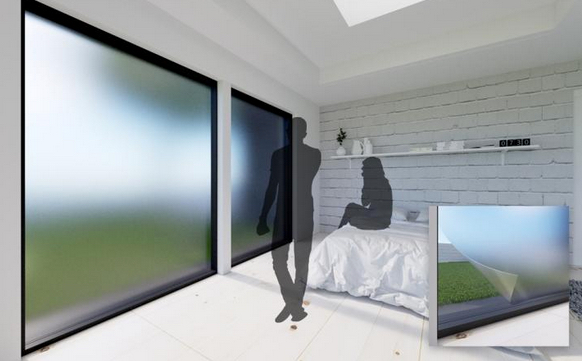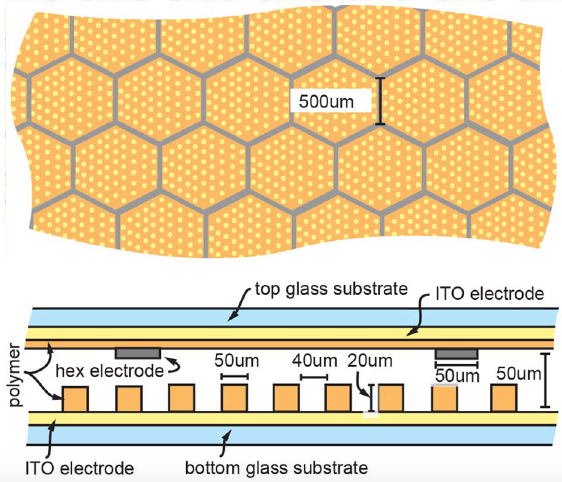Low-cost, ‘tunable’ window tintings
June 11, 2015

Window tinting can turn milky for privacy while still allowing 90 percent or more of sunlight to enter (credit: Tim Zarki, University of Cincinnati)
University of Cincinnati and university and industry partners have developed a technology for tunable window tinting that dynamically adapts for brightness, color temperatures (such as blueish or yellowish light), and opacity (to provide for privacy while allowing 90 percent or more of the light in), adjustable by the user.
According to the researchers, these “smart windows” are would be simple to manufacture, making them affordable for business and home use. The materials can also be applied to already existing windows, using a roll-on coating consisting of a honeycomb of electrodes. The tinting can be adjusted simultaneously for brightness/opacity and light color and allows for blocking infrared radiation to reduce incoming heat in the summer.

Diagram of device construction with dimensions, showing top view and cross-sectional view (roll-on coating option and filling of the electrophoretic ink dispersion not shown) (credit: S. Mukherjee et al./Applied Optics)
The device can switch between four states: clear, black, either of two complementary colors from RGB and CMY sets, and mixed states between any one of these four states. The technology is also applicable for transilluminated signs.
The research, partly funded by the National Science Foundation, is the cover story in the June issue of the journal Applied Optics. University of Cincinnati partners were Institute of Applied Mechanics of National Taiwan University, Hewlett Packard, and EMD/Merck Research Labs.
Abstract of Electrokinetic pixels with biprimary inks for color displays and color-temperature-tunable smart windows
We report on the advanced implementation of the biprimary color system in applications where subtractive color is performed inside a single pixel to alter the magnitude and color of reflection (electronic paper displays) or the optical transmission and color temperature (smart windows). A novel device structure can switch between four states: clear, black, either of two complementary colors from RGB and CMY sets, and also mixed states between one of these four states. The device structure utilizes an electrokinetic pixel structure, which combines the spectral performance of in-plane electrophoretic devices with the improved switching speeds of vertical electrophoresis. The electrophoretic dispersions are dual-particle dual-colored and are controlled using two traditional planar electrokinetic electrodes on the front and back substrates, along with a third electrode conveniently located at the perimeter of each unit cell. Demonstrated performance includes contrast ratios reaching ∼10∶1, reflectance of ∼62%, and transparency of ∼75%. For electronic paper displays, these results provide a pathway to double the reflective performance compared to the traditional RGBW color-filter approach. For smart windows, the technology provides not only control of shade (transmission) but also provides complete control over color temperature. Furthermore, this three-electrode device can be roll-to-roll fabricated without need for any alignment steps, requiring only a single micro-replication step followed by self-aligned contact printing of the third electrode.